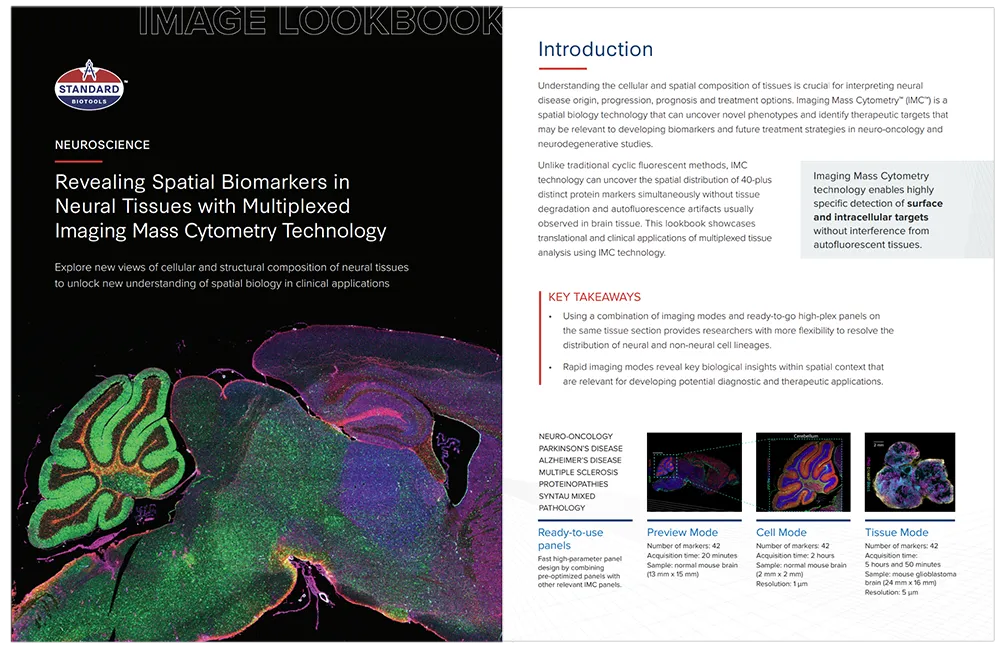Understanding the pathology of neurological disorders
To understand brain function, it is essential to know not only what cells are present, but also what they do. And while the brain is incredibly complex, an in-depth understanding of the purpose of each cell and how they interact can direct how we prevent, address and cure dysfunctions caused by disease and degeneration.
Understanding the pathology of neurological disorders
To understand brain function, it is essential to know not only what cells are present, but also what they do. And while the brain is incredibly complex, an in-depth understanding of the purpose of each cell and how they interact can direct how we prevent, address and cure dysfunctions caused by disease and degeneration.
How can we look at so many cells at once?
The brain’s complexity lies in the organization and compartmentalization of billions of neurons, mixed among other cell types, to create a dynamic network of communication and functional pathways.
Protein profiling cohesively analyzes phenotypic and functional characteristics of cells across physiological and pathological states and is essential when so many cell types act harmoniously for a given function.
High-content solutions in serum, spatial, and single-cell proteomics and multi-omics provide the necessary coverage to analyze all cells in tandem – evaluating how they work together to maintain a healthy brain or alter their functions in a disease state.
How can we look at so many cells at once?
The brain’s complexity lies in the organization and compartmentalization of billions of neurons, mixed among other cell types, to create a dynamic network of communication and functional pathways. Protein profiling cohesively analyzes phenotypic and functional characteristics of cells across physiological and pathological states and is essential when so many cell types act harmoniously for a given function. High-content solutions in serum, spatial, and single-cell proteomics and multi-omics provide the necessary coverage to analyze all cells in tandem – evaluating how they work together to maintain a healthy brain or alter their functions in a disease state.
Influences of neurological disease
Neurodegeneration
Immune response plays a significant role in the progression of neurodegenerative diseases such as Parkinson’s disease, Alzheimer’s disease and multiple sclerosis. The ability to simultaneously explore numerous biological outputs that provide new perspectives on the extensive composition of the neurodegenerative brain can open avenues for potential new diagnostic and therapeutic applications.
Advancing biomarker discovery in neurological diseases through CSF proteomics
HIGH-PLEX PROTEOMICS
Using proteomics to advance understanding of Alzheimer’s Disease webinar
HIGH-PLEX PROTEOMICS
Cancer
Gliomas present a complex form of brain cancer that is challenging to diagnose and treat, with a median survival of just over one year after diagnosis for primary glioblastoma (GBM). GBM can occur as multi-lesion, remote or diffuse tumors, and often contains a tumor microenvironment that is devoid of peripheral immune cells.
Multiparameter Quantitative Analysis of Cells in Brain Tissues webinar
SPATIAL PROTEOMICS
Inflammation
Brain inflammation can result in neuronal cell dysfunction and synaptic injury with short-term impairment that can increase the risk of neuronal cell death and long-term cognitive decline and dementia. Following the trajectory of acute and chronic neuroinflammation can help determine affected cell subsets and associated proteins.
The influence of inflammation on mental health: Researcher spotlight
SINGLE-CELL PROTEOMICS
Understanding the neuroinflammation of severe COVID-19 infection webinar
SPATIAL PROTEOMICS
In the Spotlight
Browse through the Image Lookbook to explore a detailed view of the cellular and structural composition of neural tissues – unlocking new understanding of neuro-oncology and neurodegeneration

Solutions at all levels of research
Standard BioTools’ uniquely scalable technologies offer the highest levels of content and precision in the life science industry, enabling researchers to discover novel biological insights not accessible by other approaches.
Biomark™
Understanding pathological variants and genotype–phenotype associations in neurological diseases is critical for early diagnosis and management. As a high-performing high-throughput genomics platform, Biomark™ X9 enables the flexibility to easily modify assay panels to best fit the newest and most relevant targets.
CyTOF™
CyTOF™ technology enables high-coverage and simultaneous analysis of protein markers in single cells, which is especially important for capturing rare cell types and monitoring drug access and biodistribution, and provides information on specific brain cells and biological pathways that are crucial to properly maintain cognitive activities.
SomaScan™
More than 3,500 protein targets associated with neurology can be measured using the SomaScan™ 11K Assay, which can detect low-abundance proteins in complex sample types, including cerebrospinal fluid and blood. By leveraging high-content profiling, the platform can be used in research related to disease and disease progression, ultimately translating to faster drug development.
Hyperion™
Spatial phenotyping with Imaging Mass Cytometry™ (IMC™) enables comprehensive assessment of the structural and cellular organization of the neural tissue microenvironment, including activation of neurodegenerative processes, identifying neural cell lineages and detecting immune cell infiltration in spatial context to better understand disease progression.
Featured Article:
Deciphering one of the most challenging forms of cancer
Take an in-depth look into the spatial landscape of neoplastic brain tissue
Publications
Take a look through impactful research focusing on understanding the complexity of the central nervous system in healthy and diseased states, and then applying that knowledge to predictors of progression and the development of novel approaches to treatment.
